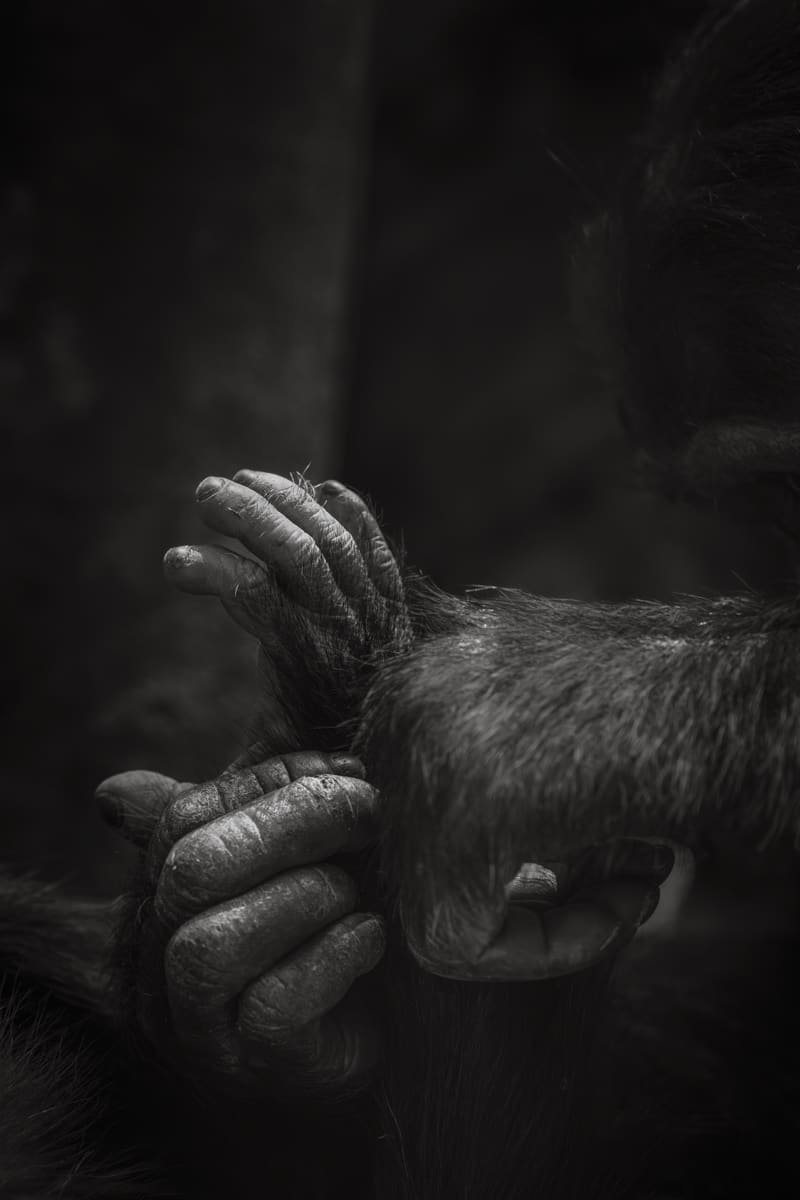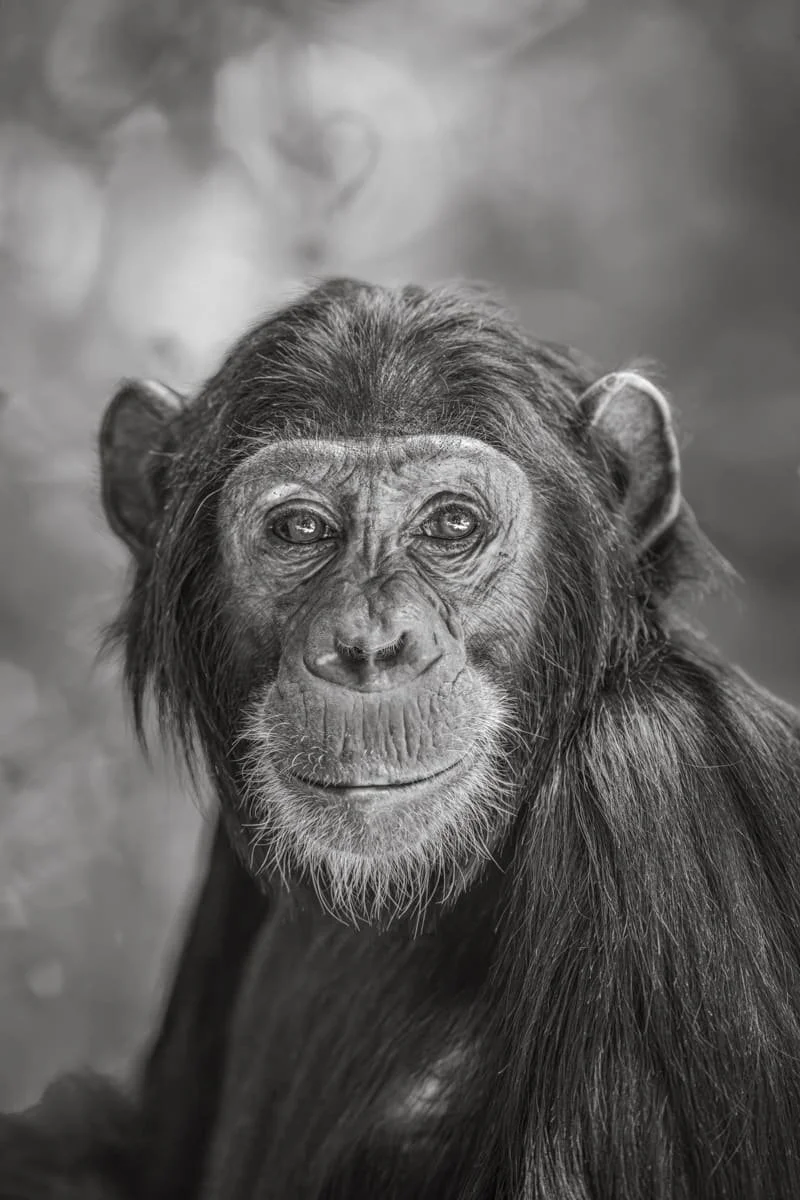How to Photograph Chimpanzees on Safari: A Guide for Wildlife Photographers
Few wildlife experiences compare to coming face-to-face with wild chimpanzees. Intelligent, emotional, and endlessly expressive, they offer a rare photographic opportunity that combines portraiture, behavior, and storytelling. Spending time with wild chimpanzees feels like looking into a mirror that reflects both our shared past and our place in nature.
They’re our closest living relatives, sharing nearly 98.7% of our DNA, and watching them reveals traits we often think of as uniquely human like curiosity, empathy, jealousy, playfulness, even grief.
They form deep family bonds, comfort each other, and work together to solve problems. Watching a mother guiding her infant through the forest, children playing, or a large male quietly asserting dominance with a glance can feel profoundly familiar.
Where to Find Them
Global numbers are estimated between 170,000 and 300,000 individuals, though precise figures are uncertain. The IUCN lists all subspecies as endangered, primarily due to deforestation, poaching, and disease. Chimpanzees inhabit tropical forests across central and western Africa, but East Africa, where I work offers, has accessible and ethical trekking opportunities.
Gombe Stream National Park, Tanzania: Famous for Dr. Jane Goodall’s pioneering research, Gombe’s compact forest and habituated communities make it an intimate setting for photography. If you’re planning a visit, explore my Complete Guide to Gombe National Park for tips on how to get there, where to stay, and what to expect.
Mahale Mountains National Park, Tanzania: A remote paradise on Lake Tanganyika, Mahale offers fewer crowds and stunning light filtering through dense forest canopies.
Kibale Forest and Budongo Forest, Uganda: Larger forest reserves where treks can involve longer hikes but offer superb chances for action shots and family interactions.
Chimpanzee Behavior and Social Structure
Chimpanzees live in complex social groups, often traveling through the forest in small sub-groups. They spend much of the day foraging, grooming, and resting in the shade, creating moments that reveal their personalities and relationships. Group size and composition change throughout the day. A community might number between 20 and 150 individuals, breaking into smaller parties to feed or travel before regrouping.
Key behaviors relevant to photographers include:
Social Bonds: Grooming is central to chimp life. It reinforces relationships and offers calm, intimate photographic moments.
Hierarchy: Each community is led by a dominant alpha male, who asserts authority through behavior such as branch-shaking or drumming on tree trunks.
Tool Use: Chimpanzees are famous for using sticks to fish for termites or crack nuts, encounters that capture their intelligence and dexterity.
Communication: They use a complex mix of gestures, facial expressions, and vocalizations (hoots, screams, grunts), often revealing emotional expression.
Arboreal Life: Although they move adeptly on the ground, chimps spend much time in the trees, especially nesting and feeding. Photographers must watch for overhead action.
Photographing Chimpanzees: Field Techniques and Considerations
Photographing wild chimpanzees is unlike photographing any other primate. They live in dense, shaded forests, move quickly, and spend much of their lives high in the canopy making them among the most challenging subjects to photograph. With the right approach, the outcomes are extremely rewarding, including portraits full of emotion, intelligence, and wild character.
Light and Exposure in the Forest
Chimpanzee habitats are typically dim, with strong contrast between sunlit clearings or open sky and shadowed forest floor.
Use wide apertures: Low f-stops like f2.8 let you gather light, keep your ISO down, and increase your shutter speed. Chimpanzees often rest well off open trails and shooting at wider apertures can help isolate subjects while blurring distracting foreground and background elements.
Raise your ISO confidently. I often shoot at ISO 6,400 without issues and shifting your exposure to the right lets you capture more data from darker areas of your composition - particularly in the chimpanzee itself.
Shoot in RAW to recover details in shadows.
Look for natural spotlights, such as dappled beams filtering through the canopy, which can turn an ordinary shot into a striking portrait. This may require underexposure, as exposing for the dark fur of the chimpanzee will blow out your highlights in these conditions.
Anticipate Behavior
Like all wildlife photography, understanding your subject can give you precious seconds to recognize when truly interesting behavior is about to occur. Chimpanzee movements are fast and unpredictable, but patterns emerge with observation:
Grooming sessions are calm, often giving you time for eye-level, emotional shots. Try to capture the interaction between the chimpanzees, going wider to get both bodies in their environment. You can also zoom in tighter to focus on the hands of the chimpanzee grooming its companion or the expression of the face of the other. This lends itself to portrait photography and you can reduce your shutter speed and ISO to avoid noise.
Feeding parties can be dynamic. Stay observant for fruiting trees, where chimps climb, leap, and interact actively. You’ll notice falling fruit debris falling from the canopy queuing you in to the action overhead. Foraging groups are incredibly mobile and you may see them climbing, swinging from branches, or suddenly making their way to the forest floor. One challenge is the combination of a dark subject in complete shade, backlit against an over exposed sky. Lean into it with a high-key shot and don’t be afraid to blow out the highlights to properly expose your subject.
Dominance displays like tree drumming, charging, or hooting choruses, often follow a build-up of tension in the group. This usually explodes without much additional warning and dissipates just as quickly. When you sense the change in the group’s mood, quickly bump your shutter speed and ISO to catch action sequences.
Tool use scenes (like termite and ant fishing) are rare but iconic. Stay patient and position yourself quietly if you notice a chimpanzee holding a stick or twig. Unlike the Serengeti or other parks where towering termite mounds are easy to spot, their analogues in forests are better hidden. You’ll observe chimps checking dead logs and holes in the sides of drainage embankments to seek ants or termites. Chimps will stay at a feeding location for a decent amount of time. Take your time, and experiment with types of compositions to capture the character of the scene.
The best chimpanzee photographs often come after sustained, quiet observation. Allow time to watch before shooting. You’ll begin to sense rhythms, relationships, and personalities. Once you spend a bit of time with family groups, you’ll get to know the individuals and each of their personalities. Capturing that personality in a photograph can make for an incredibly compelling image.
Composition and Perspective
Eye contact transforms a photo and, like other wildlife photography, the lower the shooting angle the better. Do respect the chimpanzee’s space and avoid intense or prolonged eye contact. This can be a sign of aggression and will make the animal feel discomfort and stress.
Include environment. Forest context adds depth and story to portraits. Wide lenses can capture scale when chimps are visible in the canopy. This usually takes some experimentation, balancing environment with the addition of the cluttered distraction of sticks, trees, and other elements.
Use selective framing to emphasize hands, eyes, or gestures. These details reveal emotion and personality and can capture how similar our two species are.
Ethics and Field Etiquette
Photographing habituated chimps means following strict guidelines:
Keep at least 10 meters distance to minimize disease risk and avoid putting pressure on the chimps. You’ll have far better photos if your own behavior lets the animals be themselves, and this generally means giving them ample space.
Wear masks when required, usually starting just before you begin an encounter and lasting throughout the entire duration. Respiratory infections can be deadly to chimps, and influenza (and likely COVID) has hit local chimpanzee populations.
Never mimic calls or use flash. You’d never bait an animal, and mimicking calls disturbs chimpanzees behavior. Staying quiet throughout the encounter and avoiding sudden movements lets them see you as predictable, and less threatening.
Respect the guides’ judgment. You’ll almost always be with park rangers and local trackers or guides who are able to read subtle signs of stress or agitation. When they signal you to change your approach, heed their guidance.
Gear Tips
A fast telephoto zoom (70–200mm or 100–400mm) balances reach and flexibility in dense vegetation. My main lens is always my 70-200 f2.8, but occasionally use the 400 f2.8 for added reach to isolate a subject element (like a headshot or hands). Although I’ve brought my wide angle (16-35 f2.8), I find the opportunities to use it limited.
You’ll thank yourself for keeping your gear light, and the weight savings of newer mirrorless systems helps reduce fatigue on steep terrain. You can skip the tripod, as it’s impractical on uneven terrain and you’ll need to follow groups of chimps on the move in a moment’s notice.
If you’re trekking in the wet season, bring weather protection for both you and your camera. Downpours are sudden and frequent and you may not be able to predict the change in weather when you start your trek.
Silent shooting modes help capture close moments without distraction or disturbing the animals.
Conclusion
Photographing chimpanzees is more than a technical challenge. It’s an encounter with kinship, intelligence, and raw nature. Every trek through the forest brings moments of quiet observation and sudden drama. With patience, respect, and curiosity, you’ll capture not just the image of a wild chimpanzee, but a glimpse of ourselves in the wild.
Want to refine your field skills across Africa? Join one of my guided wildlife photography safaris for immersive, small-group experiences with Africa’s most iconic wildlife.





